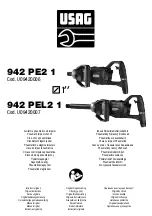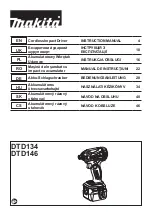
GENERAL SAFETY RULES - FOR ALL BATTERY OPERATED TOOLS
WARNING! Read all instructions.
Failure to follow all instructions listed below
may result in electric shock, fire and/or serious injury. The term “power tool” in all of
the warnings listed below refers to your mains-operated (corded) power tool or
battery-operated (cordless) power tool.
SAVE THESE INSTRUCTIONS
1) Work area safety
a) Keep work area clean and well lit.
Cluttered or dark areas invite accidents.
b) Do not operate power tools in explosive atmospheres, such as in the presence of
flammable liquids, gases or dust.
Power tools create sparks which may ignite the
dust or fumes.
c) Keep children and bystanders away while operating a power tool.
Distractions can
cause you to lose control
2) Electrical safety
a) Power tool plugs must match the outlet. Never modify the plug in any way. Do
not use any adapter plugs with earthed (grounded) power tools.
Unmodified plugs
and matching outlets will reduce risk of electric shock.
b) Avoid body contact with earthed or grounded surfaces such as pipes, radiators,
ranges and refrigerators.
There is an increased risk of electric shock if your body is
earthed or grounded.
c) Do not expose power tools to rain or wet conditions.
Water entering a power tool
will increase the risk of electric shock
d) Do not abuse the cord. Never use the cord for carrying, pulling or unplugging the
power tool. Keep cord away from heat, oil, sharp edges or moving parts.
Damaged or entangled cords increase the risk of electric shock.
e) When operating a power tool outdoors, use an extension cord suitable for out-
door use.
Use of a cord suitable for outdoor use reduces the risk of electric shock.
3) Personal safety
a) Stay alert, watch what you are doing and use common sense when operating a
power tool. Do not use a power tool while you are tired or under the influence of
drugs, alcohol or medication.
A moment of inattention while operating power tool may
result in serious personal injury.
b) Use safety equipment. Always wear eye protection.
Safety equipment such as
dust mask, non-skid safety shoes, hard hat, or hearing protection used for appropriate
conditions will reduce personal injuries.
c) Avoid accidental starting. Ensure the switch is in the off-position before plugging
in.
Carrying power tools with your finger on the switch or plugging in power tools that
have the switch on invites accidents.
d) Remove any adjusting key or wrench before turning the power tool on.
A wrench
or a key left attached to a rotating part of the power tool may result in personal injury.
e) Do not overreach. Keep proper footing and balance at all times.
This enables bet-
ter control of the power tool in unexpected situations.
f) Dress properly. Do not wear loose clothing or jewelry. Keep your hair, clothing
and gloves away from moving parts.
Loose clothes, jewelry or long hair can be
caught in moving parts. Air vents often cover moving parts and should also be avoided.
g) If devices are provided for the connection of dust extraction and collection
facilities, ensure these are connected and properly used.
Use of these devices can
reduce dust-related hazards.
4) Power tool use and care
a) Do not force the power tool. Use the correct power tool for your application.
The
correct power tool will do the job better and safer at the rate for which it was designed.
b) Do not use the power tool if the switch does not turn it on and off.
Any power tool
that cannot be controlled with the switch is dangerous and must be repaired.
c) Disconnect the plug from the power source and/or the battery pack from the
power tool before making any adjustments, changing accessories, or storing
power tools.
Such preventive safety measures reduce the risk of starting the power
tool accidentally.
d) Store idle power tools out of the reach of children and do not allow persons
unfamiliar with the power tool or these instructions to operate the power tool.
Power tools are dangerous in the hands of untrained users.
e) Maintain power tools. Check for misalignment or binding of moving parts,
breakage of parts and any other condition that may affect the power tools
operation. If damaged, have the power tool repaired before use.
Many accidents
are caused by poorly maintained power tools.
f) Keep cutting tools sharp and clean.
Properly maintained cutting tools with sharp
cutting edges are less likely to bind and are easier to control.
g) Use the power tool, accessories and tool bits etc., in accordance with these
instructions and in the manner intended for the particular type of power tool,
taking into account the working conditions and the work to be performed.
Use of
the power tool for operations different from those intended could result in a hazardous
situation.
5) Battery tool use and care
a) Ensure the switch is in the off position before inserting battery pack.
Inserting the
battery pack into power tools that have the switch on invites accidents.
b) Recharge only with the charger specified by the manufacturer.
A charger that is
suitable for one type of battery pack may create a risk of fire when used with another
battery pack.
c) Use power tools only with specifically designated battery packs.
Use of any other
battery packs may create a risk of injury and fire.
d) When battery pack is not in use, keep it away from other metal objects like
paper clips, coins, keys, nails, screws, or other small metal objects that can
make a connection from one terminal to another.
Shorting the battery terminals
together may cause burns or a fire.
e) Under abusive conditions, liquid may be ejected from the battery, avoid contact.
If contact accidentally occurs, flush with water. If liquid contacts eyes, addition-
ally seek medical help.
Liquid ejected from the battery may cause irritation or burns.
6) Service
a) Have your power tool serviced by a qualified repair person using only identical
replacement parts.
This will ensure that the safety of the power tool is maintained.
Additional Specific Safety Rules
•
Hold tool by insulated gripping surfaces when performing an operation where the
cutting tool may contact hidden wiring.
Contact with a “live” wire will make exposed
metal parts of the tool “live” and shock the operator.
•
Use proper safety goggles or other eye protection.
Hammering and drilling operations
cause chips to fly. Flying particles can cause permanent eye damage.
•
Bits, sockets and tools get hot during operation.
Wear gloves when touching them.
•
Do not operate this tool for long periods of time.
Vibration caused by tool action may
be harmful to your hands and arms. Use gloves to provide extra cushion and limit
exposure by taking frequent rest periods.
WARNING: Some dust created by power sanding, sawing, grinding, drilling, and
other construction activities contains chemicals known to cause cancer, birth defects
or other reproductive harm.
Some examples of these chemicals are:
• lead from lead-based paints,
• crystalline silica from bricks and cement and other masonry products, and
• arsenic and chromium from chemically-treated lumber (CCA).
Your risk from these exposures varies, depending on how often you do this type of work. To
reduce your exposure to these chemicals: work in a well ventilated area, and work with
approved safety equipment, such as those dust masks that are specially designed to filter
out microscopic particles.
•
Avoid prolonged contact with dust from power sanding, sawing, grinding, drilling,
and other construction activities. Wear protective clothing and wash exposed areas
with soap and water.
Allowing dust to get into your mouth, eyes, or lay on the skin may
promote absorption of harmful chemicals.
WARNING: Use of this tool can generate and/or disburse dust, which may cause
serious and permanent respiratory or other injury.
Always use NIOSH/OSHA approved
respiratory protection appropriate for the dust exposure. Direct particles away from face and
body.
CAUTION: When not in use, place tool on its side on a stable surface where it will
not cause a tripping or falling hazard.
Some tools with large battery packs will stand
upright on the battery pack but may be easily knocked over.
CAUTION: Wear appropriate personal hearing protection during use.
Under some
conditions and duration of use, noise from this product may contribute to hearing loss.
SAFETY GUIDELINES - DEFINITIONS
It is important for you to read and understand this manual. The information it contains
relates to protecting YOUR SAFETY and PREVENTING PROBLEMS. The symbols below
are used to help you recognize this information.
DANGER:
Indicates an imminently hazardous situation which, if not avoided, will result
in death or serious injury.
WARNING:
Indicates a potentially hazardous situation which, if not avoided, could
result in death or serious injury.
CAUTION:
Indicates a potentially hazardous situation which, if not avoided, may result
in minor or moderate injury.
CAUTION:
Used without the safety alert symbol indicates potentially hazardous situation
which, if not avoided, may result in property damage.
•
The label on your tool may include the following symbols. The symbols and their
definitions are as follows:
V ..........volts
A ..........amperes
Hz ........hertz
W ..........watts
min ......minutes
........alternating current
....direct current
no ........no load speed
........Class II Construction
…/min ..revolutions
........earthing terminal
..............
per minute
........safety alert symbol
BPM......beats per minute
Battery Cap Information
Battery storage and carrying caps are provided for use whenever the battery is out of the
tool or charger. Remove cap before placing battery in charger or tool.
WARNING:
Do not store or carry battery so that metal objects can contact exposed
battery terminals. For example, do not place battery in aprons, pockets, tool boxes,
product kit boxes, drawers, etc. with loose nails, screws, keys, etc. without battery cap.
Transporting batteries can possibly cause fires if the battery terminals inadvertently come
in contact with conductive materials such as keys, coins, hand tools and the like. The US
Department of Transportation Hazardous Material Regulations (HMR) actually prohibit
transporting batteries in commerce or on airplanes (i.e. packed in suitcases and carryon
luggage) UNLESS they are properly protected from short circuits. So when transporting
individual batteries, make sure that the battery terminals are protected and well insulated
from materials that could contact them and cause a short circuit.
INSTRUCTION MANUAL
SAVE THIS MANUAL FOR FUTURE REFERENCE.
CAT. NOS. XT12ID, XT14ID
FORM NO. 90517877
JULY 2007
Copyright © 2007Black & Decker
Printed in China
1
1
1
1
2
2
2
2
,,
,,
1
1
1
1
4
4
4
4
..
..
4
4
4
4
V
V
V
V
o
o
o
o
ll
ll
tt
tt
C
C
C
C
o
o
o
o
rr
rr
d
d
d
d
ll
ll
e
e
e
e
s
s
s
s
s
s
s
s
II
II
m
m
m
m
p
p
p
p
a
a
a
a
c
c
c
c
tt
tt
D
D
D
D
rr
rr
ii
ii
v
v
v
v
e
e
e
e
rr
rr
Catalog Numbers:
XT12ID, XT14ID
BEFORE RETURNING THIS PRODUCT
FOR ANY REASON PLEASE CALL
1-800-544-6986
BEFORE YOU CALL, HAVE THE CATALOG No. AND DATE CODE AVAILABLE. IN MOST CASES, A
BLACK & DECKER
REPRESENTATIVE CAN RESOLVE THE PROBLEM OVER THE PHONE. IF YOU HAVE A
SUGGESTION OR COMMENT, GIVE US A CALL. YOUR FEEDBACK IS VITAL TO BLACK & DECKER.
T
T
HANK
HANK
YOU
YOU
FOR
FOR
CHOOSING
CHOOSING
B
B
LACK
LACK
&
&
D
D
ECKER
ECKER
!
!
G
G
O
O
T
T
O
O
WWW
WWW
.B
.B
LACKAND
LACKAND
D
D
ECKER
ECKER
.
.
COM
COM
/N
/N
EW
EW
O
O
WNER
WNER
T
T
O
O
REGISTER
REGISTER
YOUR
YOUR
NEW
NEW
PRODUCT
PRODUCT
.
.
Battery Cap

























